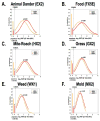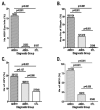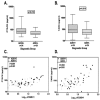Phenotype of atopic dermatitis subjects with a history of eczema herpeticum
- PMID: 19541356
- PMCID: PMC3056058
- DOI: 10.1016/j.jaci.2009.05.020
Phenotype of atopic dermatitis subjects with a history of eczema herpeticum
Abstract
Background: A subset of subjects with atopic dermatitis (AD) are susceptible to serious infections with herpes simplex virus, called eczema herpeticum, or vaccina virus, called eczema vaccinatum.
Objective: This National Institute of Allergy and Infectious Diseases-funded multicenter study was performed to establish a database of clinical information and biologic samples on subjects with AD with and without a history of eczema herpeticum (ADEH(+) and ADEH(-) subjects, respectively) and healthy control subjects. Careful phenotyping of AD subsets might suggest mechanisms responsible for disseminated viral infections and help identify at-risk individuals.
Methods: We analyzed the data from 901 subjects (ADEH(+) subjects, n = 134; ADEH(-) subjects, n = 419; healthy control subjects, n = 348) enrolled between May 11, 2006, and September 16, 2008, at 7 US medical centers.
Results: ADEH(+) subjects had more severe disease based on scoring systems (Eczema Area and Severity Index and Rajka-Langeland score), body surface area affected, and biomarkers (circulating eosinophil counts and serum IgE, thymus and activation-regulated chemokine, and cutaneous T cell-attracting chemokine) than ADEH(-) subjects (P < .001). ADEH(+) subjects were also more likely to have a history of food allergy (69% vs 40%, P < .001) or asthma (64% vs 44%, P < .001) and were more commonly sensitized to many common allergens (P < .001). Cutaneous infections with Staphylococcus aureus or molluscum contagiosum virus were more common in ADEH(+) subjects (78% and 8%, respectively) than in ADEH(-) subjects (29% and 2%, respectively; P < .001).
Conclusion: Subjects with AD in whom eczema herpeticum develops have more severe T(H)2-polarized disease with greater allergen sensitization and more commonly have a history of food allergy, asthma, or both. They are also much more likely to experience cutaneous infections with S. aureus or molluscum contagiosum.
Conflict of interest statement
Conflicts of Interest: None Declared
Figures






References
-
- Wetzel S, Wollenberg A. Eczema herpeticatum. Hautarzt. 2004;55:646–52. - PubMed
-
- Vora S, Damon I, Fulginiti V, Weber SG, Kahana M, Stein SL, Gerber SI, Garcia-Houchins S, Lederman E, Hruby D, Collins L, Scott D, Thompson K, Barson JM, Regnery R, Hughes C, Daum RS, Li Y, Zhao H, Smith S, Braden Z, Karem K, Olson V, Davidson W, Trinidade G, Bolken T, Jordan R, Tien D, Marcinak J. Severe eczema vaccinatum in a household contact of a smallpox vaccinee. Clin Infect Dis. 2008;46:1555–61. - PubMed
-
- Wollenberg A, Zoch C, Wetzel S, Plewig G, Przybilla B. Predisposing factors and clinical features of eczema herpeticum: a retrospective analysis of 100 cases. J Am Acad Dermatol. 2003;49:198–205. - PubMed
-
- Xu F, Sternberg MR, Kottiri BJ, McQuillan GM, Lee FK, Nahmias AJ, et al. Trends in herpes simplex virus type 1 and type 2 seroprevalence in the United States. JAMA. 2006;296:964–73. - PubMed
-
- Bork K, Brauninger W. Increasing incidence of eczema herpeticum: analysis of seventy-five cases. J Am Acad Dermatol. 1988;19:1024–9. - PubMed
Publication types
MeSH terms
Substances
Grants and funding
LinkOut - more resources
Full Text Sources
Other Literature Sources

